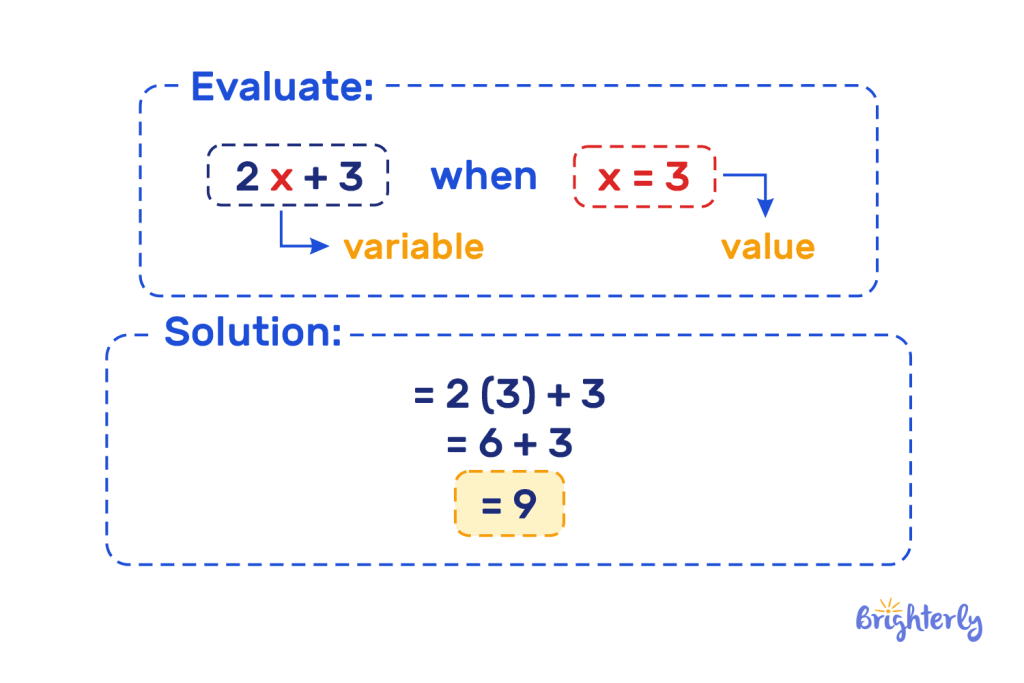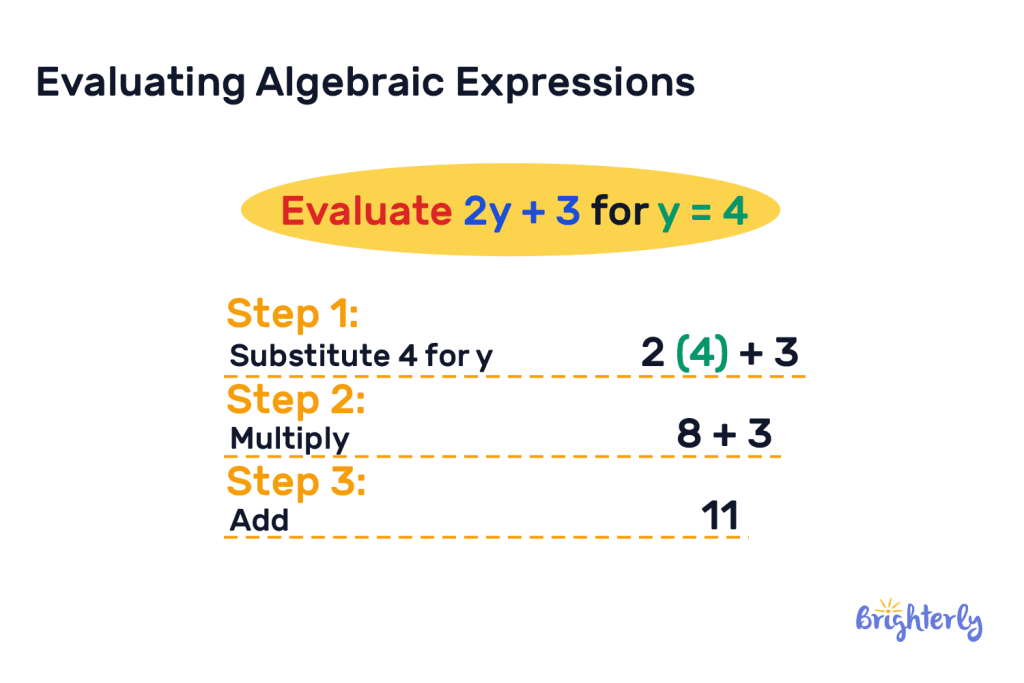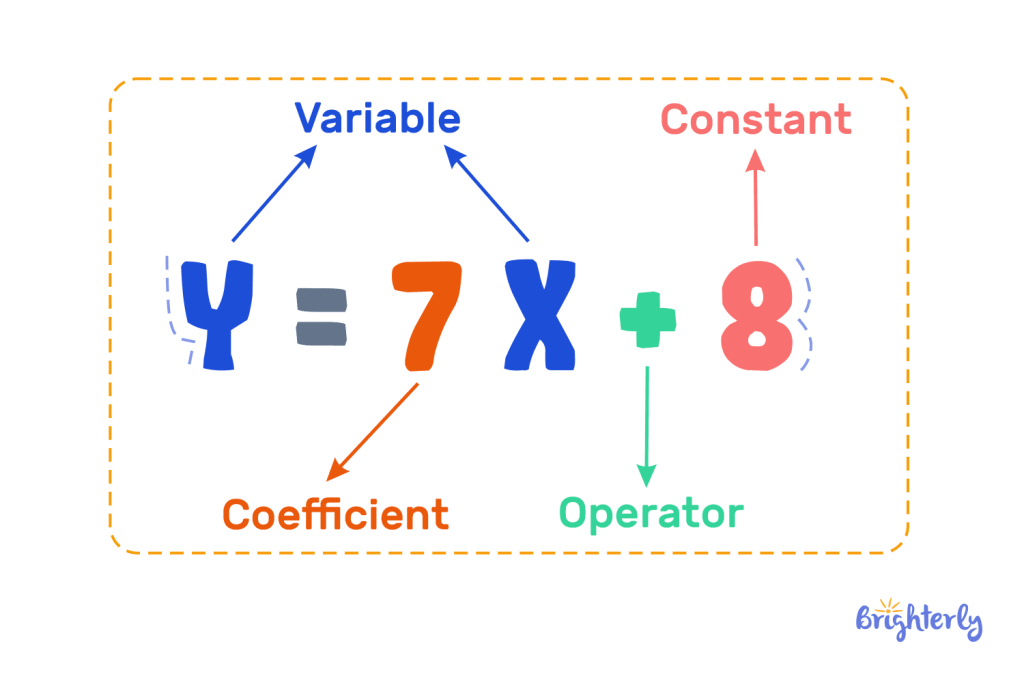Evaluate in Math – Definition, Expressions, Examples
reviewed by Jo-ann Caballes
Updated on October 21, 2024
Welcome to Brighterly, where you’ll learn all about basic and more challenging math concepts in an exciting and easy to understand way!
Today, we’re going to take a look at evaluation in math. Evaluation is a key element of algebra that helps us understand mathematical expressions and determine their underlying numerical values.
We’ll cover the evaluate math definition, how to evaluate expressions and explain the different elements in evaluating expressions. We’ll also share practice problems and fun worksheets so you can practice your learning!
What does evaluate expressions mean in math?
Evaluating the expressions means replacing the variables in a math expression with their values to understand the variable’s numerical value. A variable is a value that is generally represented by a letter like x or y. You can also evaluate equations. The evaluate the expression meaning is replacing variables in an expression with their numerical value.

Does evaluate mean simplify?
Evaluating the expressions and simplifying are different terms meaning different things. Evaluating can change the value of an expression, but it gives it a meaning and numerical value. Simplifying, meanwhile, does not change the value of an expression or equation, but it makes it easier to work with.
Does evaluate mean solve?
Evaluating and solving are often used interchangeably, but they have different meanings. Evaluation involves replacing variables represented by letters in an expression with their numerical values, while solving refers to finding the result of an expression or equation. You can solve an equation or expression (and in fact, evaluation can involve solving multiple steps), but you can’t evaluate all equations or expressions.
What does evaluate mean example?
Evaluate means to replace a variable, or variables, in a math expression with their numerical values, then simplify that expression to get your final numerical value.
Let’s use the evaluate math example of the mathematical expression 5x – 3. If you’re asked to evaluate it for x = 2, you would replace x in your original expression with 2 and simplify it. This would result in the expression of (5 x 2) – 3 = 7.
Evaluation can help us see the outcome of specific scenarios, which is especially helpful in real-world problem solving.
How to do evaluating expressions
To evaluate an expression, you need to replace a variable (usually represented with a letter such as x or y) with its numerical value and complete the expression.
Sometimes, you’ll know the value of your variable. As an evaluate in math example, if you need to work out 3x + 2, where you’re given the value of x as 4, you can work this out with the following equation: (3 x 4) + 2 = 14.
Sometimes, you may need to work out the variable yourself. If we have y x 5 = 25, we can work out the value of y by reversing the equation: 25 ÷ 5 = 5. Therefore, we know the value of x is 5.

What does it mean to evaluate an algebraic expression?
To evaluate an algebraic expression, you find the value (or answer) of the expression by replacing your variable with a given number. From there, you can solve your expression.
Definition of algebraic expressions
In order to fully understand evaluating algebraic expressions, it’s helpful to understand the definition of an algebraic expression. An algebraic expression is a symbol or combination of symbols that may include terms, mathematical operators, coefficients, variables and constants. However, unlike equations, expressions don’t have an equals sign.
Evaluate the expression examples: terms, coefficients, variables, and constants
There are some key terms you need to be aware of when it comes to evaluating the expressions:
- Terms: a term is any number, variable or product of a number or variable in an expression. For example, in the expression 2 + 3y, both 2 and 3y are expressions.
- Coefficients: a coefficient is the combination of a number and a variable, which need to be multiplied together. For example, in the expression 2x + 3y, both 2x and 3y are coefficients.
- Variables: a variable in an expression is any figure expressed as a letter. For example, in the expression x + 3, x is your variable.
- Constants: a constant is a number or value in an expression that doesn’t change. For example, in the expression 2 + y, 2 is your constant.

Usually, these elements will also be used with a mathematical operator, i.e. addition, subtraction, division or multiplication signs, but not all expressions will feature an operator.
Solved math tasks: examples
Are you ready to put your knowledge on evaluating expressions in math into practice? Try out our solved math tasks below and check your answers to see how well you’ve done!
How to evaluate the expression 6x + 8, where x = 3
Answer:
| 26. |
To evaluate this expression, follow these steps.
Because you know the value of x, your expression becomes (6 x 3) + 8
6 x 3 = 18
18 + 8 = 20.
How to evaluate the expression 9x + 2y, where x is 4 and y is 3
Answer:
| 42. |
To evaluate this expression, follow these steps.
With our known variables, this expression becomes (9 x 4) + (2 x 3).
9 x 4 = 36
2 x 3 = 6
36 + 6 = 42.
Using the solved expression of 7x = 35, work out the value of x
Answer:
| 5. |
To work out the value of x, we need to reverse our expression.
35 ÷ 7 = 5, so x = 5.
Evaluate in math: practice math problems
Evaluate in math: worksheets
Are you ready to put your knowledge on evaluating in math into practice? Our cool free worksheets will help you to become a whizz at evaluate math!







